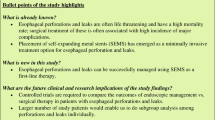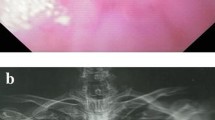Abstract
Aims
Treatment options for benign refractory esophageal stricture are limited. We retrospectively analyzed data of 11 patients who underwent fully covered self-expanding metallic stent (FC-SEMS) placement for refractory benign esophageal stricture at our institute.
Methods
Refractory benign esophageal stricture was defined as inability to dilate a stricture to a diameter of 14 mm after a minimum of five sessions at 2-week intervals or inability to maintain diameter of 14 mm for at least 4 weeks. Eleven patients with refractory benign esophageal stricture (corrosive—6, peptic—3, and post-sclerotherapy—2) underwent FC-SEMS placement. The stent was removed after 4–6 weeks as per manufacturer’s recommendation. Patients were followed up for 1 year.
Results
Three patients with peptic strictures [length of stricture 2, 3, and 3 cm] and two patients with post-sclerotherapy stricture [length 2 and 1.5 cm] had complete response. Two of 6 patients with corrosive stricture (10 cm, 12 cm) developed recurrence of symptoms within 1 month of stent removal, and two after 2 months (8 cm, 3 cm). One patient with corrosive stricture (6 cm) had recurrence after 6 months, and responded to single session of dilatation. One patient with corrosive stricture was asymptomatic for last 12 months. Four stents were migrated. Four patients developed severe retrosternal pain following stent placement, which was managed with analgesics. There were no serious adverse events after placement of stent and removal of stent.
Conclusions
Fully covered SEMS is safe and effective for refractory benign non-corrosive esophageal strictures.



Similar content being viewed by others
References
Thomas T, Abrams KR, Subramanian V, Mannath J, Ragunath K. Esophageal stents for benign refractory strictures: a meta-analysis. Endoscopy. 2011;43:386–93.
Pereira-Lima JC, Ramires RP, Zamin I, Cassal AP, Marroni CA, Mattos AA. Endoscopic dilation of benign esophageal strictures: report on 1043 procedures. Am J Gastroenterol. 1999;94:1497–501.
Kochhar R, Poornachandra KS. Intralesional steroid injection therapy in the management of resistant gastrointestinal strictures. World J Gastrointest Endosc. 2010;2:61–8.
Kochman ML, McClave SA, Boyce HW. The refractory and the recurrent esophageal stricture: a definition. Gastrointest Endosc. 2005;62:474–5.
Knyrim K, Wagner HJ, Bethge N, Keymling M, Vakil N. A controlled trial of an expansile metal stent for palliation of esophageal obstruction due to inoperable cancer. N Engl J Med. 1993;329:1302–7.
Sharma P, Kozarek R. Role of esophageal stents in benign and malignant diseases. Am J Gastroenterol. 2010;105:258–73.
Canena JM, Liberato MJ, Rio-Tinto RA, et al. A comparison of the temporary placement of 3 different self-expanding stents for the treatment of refractory benign esophageal strictures: a prospective multicentre study. BMC Gastroenterol. 2012;12:70.
Repici A, Conio M, De Angelis C, et al. Temporary placement of an expandable polyester silicone-covered stent for treatment of refractory benign esophageal strictures. Gastrointest Endosc. 2004;60:513–9.
Evrard S, Le Moine O, Lazaraki G, Dormann A, El Nakadi I, Devière J. Self-expanding plastic stents for benign esophageal lesions. Gastrointest Endosc. 2004;60:894–900.
Martin RC, Woodall C, Duvall R, Scoggins CR. The use of self-expanding silicone stents in esophagectomy strictures: less cost and more efficiency. Ann Thorac Surg. 2008;86:436–40.
Eloubeidi MA, Talreja JP, Lopes TL, Al-Awabdy BS, Shami VM, Kahaleh M. Success and complications associated with placement of fully covered removable self-expandable metal stents for benign esophageal diseases (with videos). Gastrointest Endosc. 2011;73:673–81.
Bakken JC, Song LM, De Groen PC, Baron TH. Use of a fully covered self-expandable metal stent for the treatment of benign esophageal diseases. Gastrointest Endosc. 2010;72:712–20.
Chaput U, Heresbach D, Audureau E, et al. Comparison of a standard fully covered stent with a super-thick silicone-covered stent for the treatment of refractory esophageal benign strictures: A prospective multicenter study. United European Gastroenterol J. 2013;1:93–102.
Broor SL, Chari AK, Singal A, et al. Corrosive oesophageal strictures following acid ingestion: clinical profile and results of endoscopic dilatation. J Gastroenterol Hepatol. 1989;4:55–61.
Van Halsema EE, Song LM, Baron TH, et al. Safety of endoscopic removal of self-expandable stents after treatment of benign esophageal diseases. Gastrointest Endosc. 2013;77:18–28.
Siersema PD, Hirdes MM. What is the optimal duration of stent placement for refractory, benign esophageal strictures? Nat Clin Pract Gastroenterol Hepatol. 2009;6:146–7.
Spaander MC, Baron TH, Siersema PD, et al. Esophageal stenting for benign and malignant disease: European Society of Gastrointestinal Endoscopy (ESGE) Clinical Guideline. Endoscopy. 2016;48:939–48.
Hirdes MM, Siersema PD, Van Boeckel PG, Vleggaar FP. Single and sequential biodegradable stent placement for refractory benign esophageal strictures: a prospective follow-up study. Endoscopy. 2012;44:649–54.
Author information
Authors and Affiliations
Corresponding author
Ethics declarations
Conflict of interest
VK, DG, PB, AS, and SB declare that they have no competing interests.
Ethics statement
The authors confirm that the study was performed in a manner that confirms with the Helsinki Declaration of 1975, as revised in 2000 and 2008 concerning human and animal rights, and the authors followed the policy concerning informed consent as shown in Springer.com.
Rights and permissions
About this article
Cite this article
Kahalekar, V., Gupta, D.T., Bhatt, P. et al. Fully covered self-expanding metallic stent placement for benign refractory esophageal strictures. Indian J Gastroenterol 36, 197–201 (2017). https://doi.org/10.1007/s12664-017-0764-2
Received:
Accepted:
Published:
Issue Date:
DOI: https://doi.org/10.1007/s12664-017-0764-2




